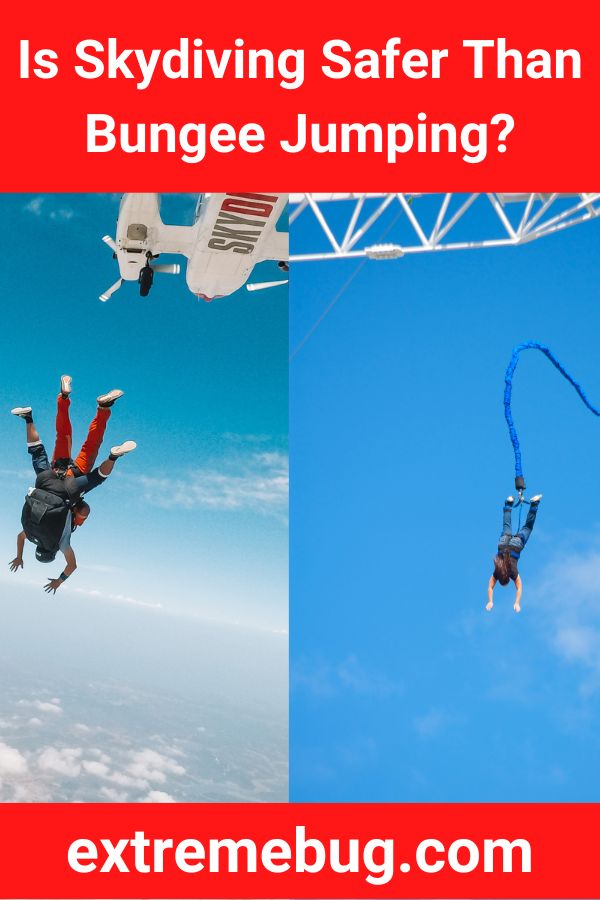Skydiving Vs. Bungee Jumping: Which Is More Dangerous?

When it comes to extreme sports, few activities are as thrilling and adrenaline-pumping as skydiving and bungee jumping. Both sports involve leaping into the void from significant heights, making them popular with thrill-seekers and adventurers worldwide. But while both offer an exhilarating experience, the question remains: Which is more dangerous, skydiving or bungee jumping? In this article, we will take an in-depth look at the inherent risks, safety statistics, and key factors that make one of these activities potentially more hazardous than the other. We will break down the science, the equipment used, the common injuries, and the safety measures in place to give you a clear, evidence-based comparison.
Understanding Skydiving Risks
Skydiving, as the name suggests, involves jumping from an aircraft at a considerable altitude and relying on a parachute to control the descent and safely land on the ground. The altitudes for skydiving jumps typically range between 10,000 and 14,000 feet (3,048 to 4,267 meters), giving participants several seconds of free fall before deploying their parachute.
Advertisements
Equipment and Technology in Skydiving
Skydiving relies heavily on high-tech equipment. Modern parachutes are made from lightweight, durable materials designed to withstand the stresses of high-speed descent. The reserve parachute is another critical safety feature, manually or automatically deployed if the primary chute fails.
Advertisements
Automatic Activation Device (AAD): This safety mechanism automatically deploys the reserve parachute if the skydiver has not activated their primary chute at a certain altitude. The device significantly reduces the risk of a fatal accident, especially in cases where the skydiver loses consciousness or is unable to deploy the chute manually.
Advertisements
Main Parachute and Reserve Parachute: These are the key components ensuring the skydiver lands safely. In the rare event of malfunction in the main parachute, the reserve serves as a backup. Both are meticulously checked before each jump, making malfunction extremely rare.
Advertisements
Altimeter: Another vital tool is the altimeter, which tracks the skydiver’s altitude. This allows the participant to know when to deploy their parachute, typically around 5,000 feet (1,524 meters) above the ground.
Risk of Equipment Failure
The risk of equipment failure in skydiving is extremely low, thanks to modern advancements in parachute technology and rigorous safety protocols. In fact, statistics from the United States Parachute Association (USPA) indicate that only 1 in every 1,000 parachutes fail to open properly. Even in those rare cases, skydivers have reserve parachutes that significantly reduce the likelihood of injury or death.
Common Injuries in Skydiving
While fatal accidents are rare, non-fatal injuries can occur, often due to poor landing techniques. The most common skydiving injuries include:
These injuries typically occur during hard landings or improper body positioning. Proper training and technique can minimize these risks.
Skydiving Fatality Rates
According to the USPA, skydiving is safer today than it has ever been. In 2022, the fatality rate was approximately 0.39 per 100,000 jumps, which translates to 1 fatality per 255,000 jumps. These numbers show that, while there are inherent risks, skydiving fatalities are exceptionally rare, especially when proper safety measures are followed.
Understanding Bungee Jumping Risks
Bungee jumping involves jumping from a fixed structure, such as a bridge, platform, or crane, while attached to an elastic cord. The jumper free-falls for a set distance before the cord stretches and recoils, slowing the descent and pulling the participant back up for a brief moment.
Equipment and Technology in Bungee Jumping
The equipment for bungee jumping is simpler compared to skydiving, but it is no less critical. The primary component is the bungee cord, made from multiple strands of latex rubber, which provides elasticity and strength. The cord is attached to a harness or ankle cuffs worn by the jumper.
Bungee Cord Strength: Bungee cords are meticulously tested for elasticity and strength. Different cords are used depending on the jumper’s weight and the type of jump, ensuring a controlled and safe experience. However, improper weight calculations or using worn-out cords can lead to accidents.
Harness: Most jumps use either a full-body harness or ankle harness, depending on the setup. A faulty harness could result in improper distribution of weight and lead to injury during the jump or rebound.
Risk of Equipment Failure
Bungee jumping equipment is subject to wear and tear, particularly the bungee cord. Although bungee operators are required to replace cords regularly, equipment failure remains a significant concern. In cases where the cord snaps or is improperly secured, the consequences can be fatal. However, incidents of complete equipment failure are rare due to strict regulations in most countries.
Common Injuries in Bungee Jumping
Bungee jumping, while generally safe when done correctly, can lead to various injuries. The most common injuries include:
- Whiplash injuries due to the rapid deceleration during the cord’s recoil
- Eye trauma from the sudden increase in pressure during the rebound phase
- Back injuries from improper jumping posture or the recoil force
Bungee Jumping Fatality Rates
Fatal accidents in bungee jumping are rare but not unheard of. The global fatality rate is estimated to be 1 in every 500,000 jumps. While this is a lower fatality rate than skydiving, the injuries that occur during bungee jumping can be more varied and unpredictable, especially when factoring in environmental conditions like wind and cord length miscalculations.
Factors Affecting Danger Levels
While both skydiving and bungee jumping come with their share of risks, several key factors determine which might be more dangerous:
Altitude and Speed
Skydiving involves jumping from a much higher altitude than bungee jumping, which means the potential for fatal accidents is greater if something goes wrong. Skydivers reach speeds of up to 120 mph (193 km/h) during free fall, adding a layer of risk that bungee jumping does not have.
Bungee jumping, on the other hand, occurs from much lower heights, usually ranging from 150 to 500 feet (46 to 152 meters). While the height and speed in bungee jumping are significantly less, the sudden deceleration at the end of the jump can cause severe injuries if the cord is improperly measured.
Control and Environment
In skydiving, participants have a higher level of control over their descent and landing, assuming the parachute deploys correctly. Skydivers can steer their parachutes and choose safe landing zones, further minimizing the risk of injury.
In bungee jumping, once the jump is initiated, the participant has little control over the descent. The jumper’s safety is entirely reliant on the bungee cord and the setup, leaving less room for human intervention if something goes wrong.
Frequency of Use and Regulation
Skydiving is a highly regulated activity, with strict rules in place to ensure safety. Jumpers undergo extensive training before their first dive, and equipment is inspected before each jump. Many countries require skydiving instructors and operators to be certified by national or international organizations, ensuring a high level of safety.
Bungee jumping regulations can vary widely depending on the country or operator. While many operators follow stringent safety standards, there is less oversight compared to skydiving. This lack of consistent regulation can contribute to higher risks, especially in countries with lax safety standards.
Conclusion
Both skydiving and bungee jumping carry inherent risks, but statistically speaking, skydiving is slightly more dangerous due to the higher speeds, altitudes, and reliance on parachute deployment. However, it is also more regulated, with better safety measures in place. The fatality rate in skydiving is slightly higher than that of bungee jumping, but the chances of serious injury are comparable between the two sports.
Bungee jumping, while considered less risky in terms of fatalities, has a higher likelihood of causing non-fatal injuries like whiplash, eye trauma, and back problems. These risks are more unpredictable, especially when factoring in variations in equipment quality and operator standards.
Ultimately, the danger level of each sport depends on a variety of factors, including equipment quality, operator reliability, and the participant’s own adherence to safety protocols. For both sports, choosing reputable operators and following safety instructions is key to minimizing risks.
FAQs:
1. Is there an age limit for skydiving and bungee jumping?
Yes, most countries have age restrictions for both sports. Skydiving generally requires participants to be at least 18 years old, while bungee jumping may allow younger participants with parental consent.
2. Do I need prior experience to try skydiving or bungee jumping?
No prior experience is needed for tandem skydiving or bungee jumping, as both activities are done under professional supervision. However, solo skydiving requires extensive training and certification.
3. Can health conditions prevent me from skydiving or bungee jumping?
Certain health conditions, such as heart problems, high blood pressure, or back issues, may prevent individuals from participating. It’s important to consult a doctor before attempting either sport.
4. Are there weather conditions that can make skydiving or bungee jumping more dangerous?
Yes, both sports are weather-dependent. High winds, rain, or storms can increase the risks. Jumps are typically rescheduled or canceled in adverse weather conditions.
related topics:
- The Thrill of the Plunge: Understanding the Speed of Bungee Jumping
- The Risks and Realities of Bungee Jumping Injuries: What You Need to Know
- How Many People Go Bungee Jumping Each Year?
You Might Be Interested In
- Bungee Jumping vs. Skydiving: What Is the Difference?
- Where Is Bungee Jumping in Nepal?
- Bungee Jumping vs. Rock Climbing: Which Adventure is Scarier?
- What Equipment Is Needed for Bungee Jumping
- What Is Crocodile Bungee Jumping
- What Type of Sport Is Bungee Jumping?
Is Skydiving Safer Than Bungee Jumping? (Find Out!)

Skydiving and bungee jumping are two birds of a feather.
They’re the activity for the thrill seekers among us, looking for the adrenaline rush of a truly awe-inspiring experience.
For those of us without that same need for thrill, safety might be the first thing on our minds.
Which one is safer, we might wonder—skydiving or bungee jumping?
Statistically, bungee jumping is a good deal safer than skydiving. Skydiving deaths are about 1 in every 220,000 jumps. Bungee jumpers are less than half of that, with 1 death every 500,000 jumps. While both come with risks, bungee jumping is certainly less risky.
Ultimately, though, both activities are very safe when done responsibly.
And there is every reason for both skydiving instructors and bungee jump instructors to adhere to safety rules to protect their business and income.
Let’s look further into this.
What’s scarier skydiving or bungee jumping?
That really depends on you as a person.
For the most part, people do tend to surprisingly say that bungee jumping is scarier than skydiving.
The fear involved with skydiving is usually over once the initial jump has been taken.
If you are able to marshal your nerves to get over the first step, the rest is a breeze-literally.
The free fall is even relaxing because you don’t have much of a sense of falling.
You hit terminal velocity and you feel as though you are floating on a cloud, soaring on the wind.
This is not scary for most people, even some who are afraid of heights.
The main thing that makes bungee jumping scarier is that the ground is typically much closer to you.
This can give a much more crystal-clear sense of falling, as compared with skydiving where the ground, for most of the jump, is far away from you.
Bungee jumping is a short, intense sensation of freefall—this is scarier for most people.
However, if the pure height is the scary thing for you, then skydiving may well be scarier.
However, both are going to be very scary experiences for those with fear of heights—there’s no way around that.
But, again, it does depend on you as a person.
The more important question, though, is whether they are safe to begin with.
Are bungee jumps safe?
Bungee jumps are, as I said, far safer than skydiving, statistically speaking.
You could do 500,000 bungee jumps and never have a single injury.
So, from a purely numerical standpoint, bungee jumping is extremely safe—much safer, say, than driving.
While bungee jumping obviously has a lot of potential for danger, the industry wouldn’t exist were there not sufficient safety standards to keep operators in line.
Bungee jump centres are someone’s business, ultimately, and their livelihood depends on keeping people safe.
It would only take one injury or death to shut the place down at worst, if not just keep everyone away.
So, bungee jump operators have every incentive to follow the safety guidelines to the letter, and ensure that no one who is at risk will ever jump.
Because the dangers of bungee jumping do not come only from the prospect of falling. If you have high blood pressure, or any kind of heart condition or anxiety disorder, bungee jumping could cause you all sorts of health complications.
Bungee jumping centers will not allow such jumpers to participate.
What about skydiving, then—is it safe?
Is skydiving safe?
Again, statistically, yes.
There is about 1 death every 220,000 skydiving jumps.
This, again, makes it safer than driving, in the simplest sense.
You are exceedingly unlikely to suffer any injury or death while skydiving, for the same reasons you are in bungee jumping.
Skydiving schools are businesses, and they are clearly incentivized to keep their operations safe.
When every safety and health rule is followed, there is little chance of anything going wrong.
Skydiving is safe, then, otherwise we wouldn’t have so many people doing it.
There are around 3 million jumps per year, and around 15 deaths.
So, which is more dangerous?
Is skydiving more dangerous than bungee jumping?
So, again, statistically, skydiving is more dangerous.
You are almost twice as likely to die while skydiving as you are while bungee jumping.
While that may sound alarming, your chances of dying while skydiving are still extremely low.
To the point that it is really not something you need to worry about.
Of course, the chances of dying aren’t zero, but you’ve got to take some degree of risk if you want to try it.
But the degree of risk is extremely small.
Bungee jumping risk is even smaller.
But past a certain point, it really doesn’t matter all that much.
Clearly, you can safely engage in both of these activities without needing to worry about death.
But the numbers don’t lie—bungee jumping is indeed safer.
So, while the simple answer is no, skydiving is not safer, both bungee jumping and skydiving are very safe things to do.
Your chances of death or injury are extremely low, and you shouldn’t be concerned about it.
Both are scary, it’s true, and you may be more at risk in terms of your own health than others, but all this will be screened by the place you jump or skydive.
Don’t let fear of safety get in the way of your chance to do either of these things.
Related Posts:

Hi I’m Todd, I started Extreme Bug because I love everything to do with Extreme Sports and the Extreme Lifestyle.
You could say I caught the bug for the Extreme way of life! I started this blog as a way of helping others interested in Extreme Sports!
© 2025 ExtremeBug.com | Privacy Policy | Site Map
As an Amazon Associate I earn from qualifying purchases. Extreme Bug also participates in affiliate programs with other sites. Extreme Bug is compensated for referring traffic and business to these companies. Extreme Bug provides access to the content on the website for informational and entertainment purposes only. Always speak to a professional before participating in any dangerous sports.
https://www.ourextremesports.com/archives/3452https://extremebug.com/is-skydiving-safer-than-bungee-jumping/

